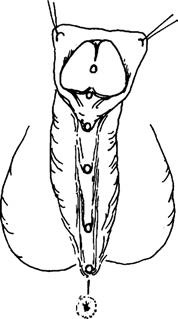Hypospadias is a relatively common congenital anomaly resulting from the incomplete closure of the urogenital groove along the ventral side of the genital tubercle during development. This condition is characterized by four features: (1) an ectopic urethral opening; (2) ventral curvature of the penis (chordee); (3) normal dorsal prepuce with a deficiency of ventral prepuce; and (4) underdevelopment of the spongy urethra, extending from the frenulum to the abnormal urethral opening, forming a thick fibrous band.
Based on the location of the ectopic urethral opening, hypospadias is classified into four types: (1) glanular, (2) penile, (3) scrotal, and (4) perineal. The last three types may impact sexual function and activity, necessitating seated urination in daily life, which can lead to significant psychological distress.

Figure 1 Possible locations of the urethral opening in cases of hypospadias
Treatment involves reconstructive surgery to restore the ability for normal standing urination and eventual sexual function in adulthood. Surgery is typically performed before school age and may be completed in one session or staged procedures. In some patients, associated conditions such as undescended testes and inguinal hernia are also addressed surgically.